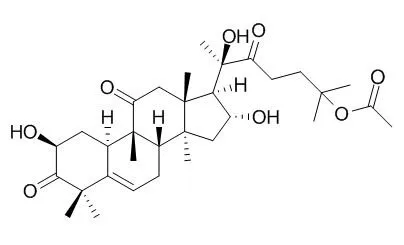We have studied the effects of Dihydrocucurbitacin B, a triterpene isolated from Cayaponia tayuya roots, on different models of delayed type hypersensitivity (DTH) in mice, as well as on T-lymphocyte proliferation and the mediators involved.
METHODS AND RESULTS:
In experiments with mice, Dihydrocucurbitacin B inhibited the inflammatory reactions induced by oxazolone, dinitrofluorobenzene, and sheep red blood cells, reducing both the edema and cell infiltration. Moreover, the analysis of inflamed tissues showed that Dihydrocucurbitacin B reduced the presence of the most relevant cytokines implicated in these processes, including interleukin-1 beta, interleukin-4, and tumor necrosis factor-alpha. Dihydrocucurbitacin B was also found to inhibit the proliferation of phytohemagglutinin-stimulated human T lymphocytes (IC(50) = 1.48 microM), halting the cell cycle in the G(0) phase. In addition, the triterpene reduced the production of interleukin-2, interleukin-4, interleukin-10, and interferon-gamma in human T lymphocytes, and it hampered the induction of the principal cyclins involved in the cell cycle, including A(1), B(1), D(2), and E(1). Finally, Dihydrocucurbitacin B was found to exert a selective inhibition on the nuclear factor of activated T cells (NFAT) in human lymphocytes without affecting the calcium influx.
CONCLUSIONS:
Taken together, these results suggest that Dihydrocucurbitacin B curbs DTH reactions by inhibiting NFAT, which in turn suppresses the proliferation of the most relevant cells involved in DTH reactions, namely the T cells. |






 Cell. 2018 Jan 11;172(1-2):249-261.e12. doi: 10.1016/j.cell.2017.12.019.IF=36.216(2019)
Cell. 2018 Jan 11;172(1-2):249-261.e12. doi: 10.1016/j.cell.2017.12.019.IF=36.216(2019) Cell Metab. 2020 Mar 3;31(3):534-548.e5. doi: 10.1016/j.cmet.2020.01.002.IF=22.415(2019)
Cell Metab. 2020 Mar 3;31(3):534-548.e5. doi: 10.1016/j.cmet.2020.01.002.IF=22.415(2019) Mol Cell. 2017 Nov 16;68(4):673-685.e6. doi: 10.1016/j.molcel.2017.10.022.IF=14.548(2019)
Mol Cell. 2017 Nov 16;68(4):673-685.e6. doi: 10.1016/j.molcel.2017.10.022.IF=14.548(2019)